Best Practices for Creating Viral Content in 2025
Best Practices for Creating Viral Content In today’s digital world, creating viral content is every marketer’s dream. A single post, video, or meme can spread like wildfire, gaining millions of views, shares, and interactions. But what makes content go viral? Is it luck, or are there proven strategies to increase your chances? While virality isn’t guaranteed, there are best practices that significantly boost the chances of your content reaching a massive audience. In this guide, we’ll explore the key factors that contribute to viral content and how you can apply them to your digital marketing strategy. 1. Understand Your Audience The foundation of viral content is a deep understanding of your target audience. If your content resonates with the right people, they are more likely to engage with it and share it with others. How to Identify Your Audience: 2. Tap into Emotions People share content that makes them feel something. The stronger the emotional reaction, the higher the chances of it going viral. Types of Emotions That Drive Shares: Example: A motivational video of someone overcoming a major obstacle often gets thousands of shares because people relate to and feel inspired by it. 3. Create Share-Worthy Headlines Your headline is the first thing people see, and it determines whether they click or scroll past. Best Practices for Viral Headlines: 4. Leverage Visual Content Visuals increase engagement and make content more shareable. Studies show that social media posts with images or videos get significantly higher engagement than text-only posts. Types of Engaging Visual Content: 5. Ride the Trend Wave Trendy topics have built-in engagement. If you create content around what’s already popular, you can tap into an existing audience. How to Identify Trends: Example: If a new challenge is trending on TikTok, brands that participate early often see increased engagement. 6. Encourage User Participation Content that invites interaction is more likely to be shared. People love to engage with posts that feel personal or require their input. Ways to Boost Engagement: 7. Optimize for Each Platform Different social media platforms favor different types of content. Make sure you tailor your posts accordingly. Best Practices for Each Platform: 8. Post at the Right Time Timing can make or break your content’s reach. Posting when your audience is most active increases visibility. Best Posting Times (General Guidelines): Use insights from analytics tools to determine your specific audience’s peak activity times. 9. Collaborate with Influencers Partnering with influencers or popular content creators can dramatically increase your reach. How to Find the Right Influencer: 10. Make Content Easily Shareable If your content is easy to share, it will spread faster. Tips to Increase Shareability: 11. Utilize Paid Promotion If your content is performing well organically, boosting it with paid ads can amplify its reach. Best Paid Promotion Strategies: 12. Monitor and Learn from Analytics Tracking the performance of your content helps you understand what works and what doesn’t. Key Metrics to Track: Use tools like Google Analytics, Facebook Insights, and TikTok Analytics to refine your strategy. Conclusion Viral content doesn’t happen by accident—it’s a mix of strategy, creativity, and timing. By understanding your audience, creating emotionally compelling content, leveraging trends, and optimizing for different platforms, you can maximize your chances of going viral. For more such content check out more article here Trendify Digital Facebook page: Trendify Digital Instagram Page: Trendify Digital
Best Practices for Creating Viral Content in 2025 Read More »
Uncategorized
